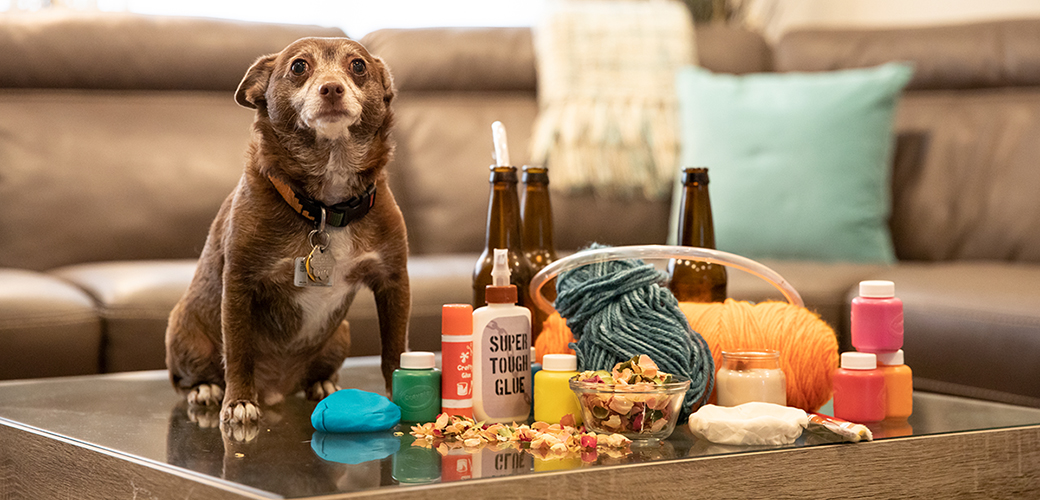These Popular Hobbies Could Pose a Threat to Pets!
blog_apcc-hobbies_071819_main.jpg


Working on a favorite craft, hobby or art project is a great way to unwind after a hard day, and for some of us, hobbies may be part of our livelihood. However, these pastimes may pose risks to pets. The ASPCA Animal Poison Control Center (APCC) has everything you need to keep in mind concerning popular hobbies, in order to keep pets safe, happy and healthy.
If There’s a Needle, Be Careful
Sewing, knitting and crochet are relaxing pastimes for many, but could pose a risk to pets due to the temptation for play that these hobbies present.
Needles, pins and stitch markers are shiny and very tempting to play with (especially for cats, as they skitter easily across the floor). Errant buttons may also be a temptation. But all these items are foreign body risks. Swallowing a foreign item could lead to choking or internal trauma and damage, and could require surgery to remove.
Pins and needles of all types are dangerous because they are sharp and could puncture delicate organs such as the stomach, intestines and esophagus if swallowed. Yarn and thread might be fun for cats and dogs, but are dangerous when swallowed (especially if the item gets caught under the tongue). When swallowed, string and yarn-type items can get caught and pull together the intestines like a draw-string, leading to damage to the lining of the intestine.
Don’t Get Caught in a Sticky Situation
Glues used in woodworking, jewelry making, or paper crafts can pose a risk to pets when ingested, depending on the glue’s type and chemical structure.
Dogs are often attracted to bottles of glue and may chew them open and ingest the contents. White glues, like basic craft glue, and cyanoacrylate-based super glues can cause irritation to the skin and the mucus membranes, but aside from this, they are relatively non-toxic to our four-legged counterparts.
Expandable construction glues and wood glues contain isocyanates that expand when they reach the acidic environment of the stomach and are very dangerous for pets. Ingestion of one of these types of glues can expand in the stomach and cause blockage that can only be removed via surgery.
Birds and some reptiles may also be affected by fumes from many of these adhesives, leading to respiratory irritation and pneumonitis.
Keep an Eye on Art Supplies
Do you have an artist in the home? Or perhaps you’re brushing up on your sculpture skills? Risks due to your pet ingesting clay will depend on the type of clay being used.
Homemade playdough or salt dough poses a risk to dogs due to the amount of salt in them. When ingested, the large amount of salt causes high blood levels of sodium (hypernatremia). Hypernatremia leads to vomiting, increased thirst, difficulty walking and even tremors and seizures. Left untreated, this could be fatal.
Modeling clays and polymer clays pose minor threats to our four-legged-friends and usually cause GI upset when ingested, although fumes from baking these clays may be dangerous to birds. The bigger risk with these clays tends to be the glazes and pigments that are often used on them. These may contain heavy metals and solvents that could be extremely toxic to your pet. If ingested, contact your local veterinarian or APCC right away. Most artist paints, like acrylic and oil paints, are fairly non-toxic, but some colors may contain unique pigments that may be a risk to pets. Always check the labels of your paint supplies to determine if they are non-toxic. In addition, paint solvents, like turpentine, when ingested, can cause vomiting and aspiration, and are very irritating to the skin and mucus membranes.
Scented Safety
If you like making candles or potpourri, you probably already know that this hobby involves the use of essential oils. Some of these oils, in pure form, may cause liver damage or may lead to issues with seizures and tremors.
Additionally, the wicks used in candle-making are another source of concern. Before they are cut to size, the long wicks can be damaging if ingested.
Brewing at Home
Brewing your own beer has become an increasingly popular hobby. The biggest concern for pets around homebrewing is hops toxicity. The hops used to make beer are very dangerous for dogs. When they ingest hops, they can develop a significant or even life-threatening increase in their body temperature. A dog’s normal temperature is usually around 101-102.5 degrees Fahrenheit. When dogs ingest hops, their temperature will spike over 102.5 degrees, putting them in a dangerous state. When a dog’s temperature reaches over 107 degrees, it is considered life-threatening. Unfortunately, it doesn’t matter what form hops come in, or if they have been used (spent) or not—they can all be dangerous and problematic for dogs.
Other problems seen when dogs ingest hops include panting or fast breathing, stomach upset (vomiting or diarrhea), agitation and an increase in heart rate. Symptoms can start as rapidly as 30 minutes after ingestion, but rarely can be delayed up to eight hours.
In addition, any alcohol can be dangerous for your furry friends, so keep your adult beverages up and away from curious noses.
Keeping Pets Safe Every Day
Now that you know what items to be wary of, what are some best practices to keep your pets as safe as possible? The biggest safety rule to follow is to do your best to prevent exposures entirely. Store all craft and art materials safely and securely in pet-proof cupboards or boxes and keep objects far out of paws’ reach. Practicing exposure prevention will give you a more pleasurable experience when following your artistic vision and will keep your favorite furry friends healthy and happy.
If you suspect your pet has been exposed to any poisonous substances or ingested something dangerous, contact your veterinarian or call Animal Poison Control Center (APCC) at 888-426-4435 immediately.
Source: Read Full Article